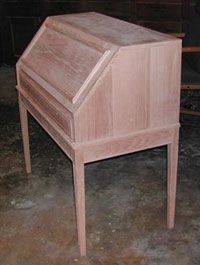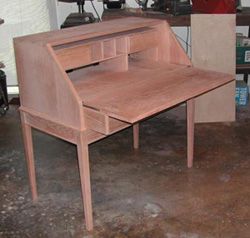
>

Question: I am a beginning woodworker but have managed to construct a secretary desk and I don't want to ruin it when I start trying to finish it. I have attached a picture of it so you can see that I have spent quite a bit of time on it. It is made out of red oak lumber that I had sawed from a large red oak tree that fell in my back yard. I have been letting it air dry for almost 18 months, stacked neatly under a shed. I think I want to darken it slightly, maybe a Minwax Early American or Provincial. I would like advice on using filler, something like your Bartley Paste Wood Filler , or something similar, and if it is recommended to use it, when is the best time, before staining, or after? If the filler goes on first, does it absorb the stain the same as the wood? Any hints, tips, or suggestions will be appreciated, so that I will know what to buy.
 Answer:
Thanks for your inquiry. You've made a beautiful
secretary. The first decision you have to make is what type of finish you want on your project. If you want a thin oil/hand rubbed finish, then there's no need to pore fill (grain fill). If you want a film finish (built up finish) or a high gloss finish, then you'll probably want to fill the grain/pores.
Answer:
Thanks for your inquiry. You've made a beautiful
secretary. The first decision you have to make is what type of finish you want on your project. If you want a thin oil/hand rubbed finish, then there's no need to pore fill (grain fill). If you want a film finish (built up finish) or a high gloss finish, then you'll probably want to fill the grain/pores.
As far as stains or colors, stick with oil-based pigment stains like Bartley's , Varathane or Minwax for an open-pored wood like your red oak. Staining is the first step after your final sanding. Of course you could choose not to color the wood and proceed directly to top coating. Once the initial coloring (stain) is dry, then if you want, you can pore fill. This takes some practice, so I'd suggest doing quite a bit of practicing before tackling your finished piece. Bartleys makes a fine pore/grain filler. It usually takes two or three coats of filler to fill red oak. Depending on your tastes you can also color the filler (usually darker) to contrast or highlight the grain. Just mix in any oil-based stain into the filler or use the dark filler. After the final coat of filler is dry, then you can top coat.
If you are just beginning, stick with an easy to use finish like Waterlox's Original Sealer/Finish or a wipe-on polyurethane. Remember, you don't have to fill the pores if you don't want a thick film finish. If you want a thinner finish, just stain and apply 2 or 3 coats of Waterlox or wipe-on poly directly over the stain or raw wood. The absolutely most important thing to do is experiment, experiment and experiment . Practice on scrap and take notes until you find a method that works for you. I would highly recommend getting a copy of Bob Flexner's Understanding Wood Finishing, Revised (203621). In my opinion, it's the best book on the subject.